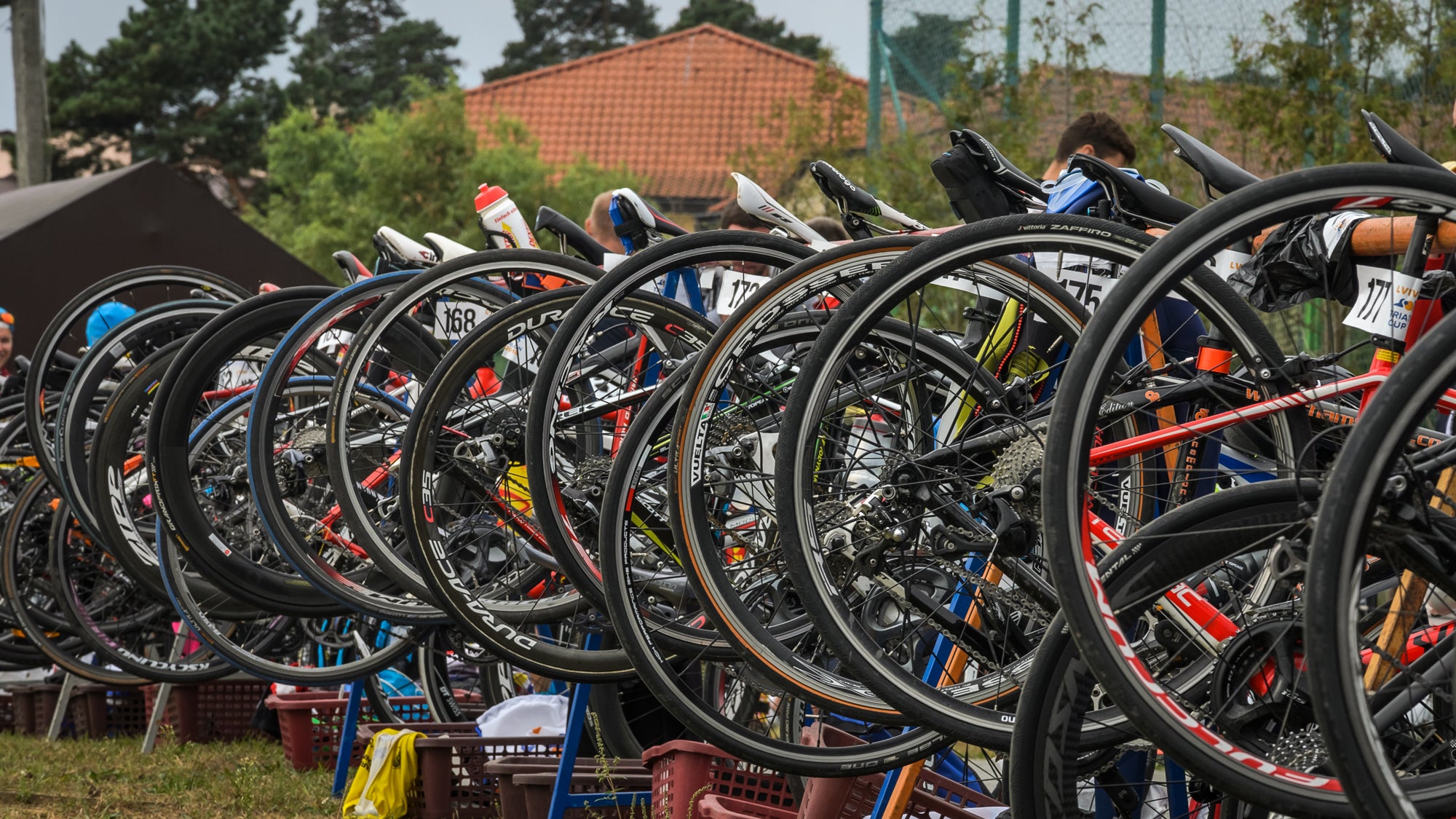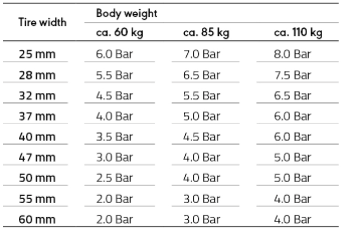Ask a Gear Guru: What Bike Tire Pressure Should I Use?

Bike tire pressure for triathlon to provide the most comfortable ride alongside performance
PRESSURE GUIDE, BY BRAND
If you’ve done tris for any amount of time, you’ve heard that horrible sound in transition during the early hours before the start of a race. Or sometimes it comes later in the morning of an iron-distance race, as the sun starts to heat everything up. That BANG. It’s the sound of a blown race, the sound of a cool, calm, relaxed start to someone’s big day being slammed suddenly into a panicked morning in hell, trying to find a tube, a pump, and the right bike tire psi. If the question is, “What bike tire pressure should I run?” The quick answer is, “not that one.” Not at all. (Side note: if you’re not sure how to change a flat tire, check out our how-to article here.)
Sure, those pre-ride blowouts used to happen much more than they do now, but that’s mostly because today we know a lot more about tires and rolling resistance and aerodynamics. The old-school way of thinking was: Get the thinnest tire you can (remember 19c tires??), blast it up to max (220psi anyone??), and double check your dental insurance deductible because you’ll probably lose some teeth bouncing around on that rough road. Tubular tires were considered great because you could go super thin, super high-pressure, and best yet – if you got a flat you were completely screwed and could throw your bike into a lava field. Tubular tires were also great for hurting your hands, making a huge mess, and forcing you into buying a special set of race wheels, but that’s neither here nor there.
Doing away with the old ways on bike tire pressure
The idea in the past was that because an under-inflated tire felt slow and mushy, the more air the better, always. The other thinking was that a thinner tire was faster because it presented a smaller profile to the wind and ground. Both theories assumed that you want only a tiny bit of something (rubber on the ground, rubber facing the air) and that less is always more no matter what.
Today, we know better. Without getting too deep into the science (read here for more), a wider tire presents a wider, but shorter contact patch with the ground – this is a good thing. Also, a tire with lower pressure deflects less on bumpy roads, meaning it doesn’t bounce around as much on a micro-scale. Not only does this give you a more comfortable ride (important for triathletes who have to run off the bike), but it also loses less speed due to the up-and-down forces you find on everyday roads. Yes, a super high-pressure tire is awesome on the smooth surface of the velodrome, but how often are you at the track?
Also, with a wider tire, you can run less pressure because you have less chance of a pinch flat – due to more distance between the tire that touches the ground and the rim itself. The good news is that wider is better (within limits), lower pressure is better (within limits), and they both play really well together for triathletes!
Tubeless tires are also having a moment because, despite being a pain in the butt to install, they allow you to run even lower pressure without the risk of a pinch flat and are less likely to get small punctures due to the sealant required. Triathletes should love tubeless tires especially if they’re using a rear disc wheel, because the super low pressure allowed really helps with a disc wheel’s inherent comfort issues.
So what bike tire pressure is best? It’s probably much less than you think, but it’s not so cut and dry, either.
Below we’ve compiled the tire pressures for a range of popular tires alongside some wheel brands’ two cents. If you’re looking to buy a new set of tires, you can check out our tire guide with a few of our favorites and more info on what to get. TL;DR? Go 25c or 28c (check first to see if your frame/fork can handle it), and get something with more flat protection than you think you’ll need. Stay on top of your tire pressure, checking it with every ride with the valve stem at 12 o’clock, and thank the New Bike Tire Pressure Gods that you have to pump less than you used to.
What bike tire pressure should I run for Vittoria Tires?
Vittoria used to have a very broad guide to tire pressure per width for a person’s given weight. That’s changed as Vittoria has now swung in the other direction with very very specific tire pressure for each model, width, and rider weight.
To find the pressure for your Vittoria tires, go to your model’s page on their site and scroll down. Some of Vittoria’s most popular tires for triathletes include:
What bike tire pressure should I run for Continental Tires?
This one’s a little trickier. Continental has mostly scrubbed any tire pressure information from its website and advises riders to “consult the included tire-pressure booklet.” In our experience, Continental likes to give pretty big ranges for their recommended pressure, and we’ve found riders under 190lbs can stick closer to the minimum recommended, while riders between 190-220lbs should head to the midrange; 220lbs and above should be near max recommended.
| Continental Grand Prix 5000 | |
| 700 X 32C | 85-100psi |
| 700 X 28C | 95-115psi |
| 700 X 25C | 95-120psi |
| 700 X 23C | 110-120psi |
| Continental Grand Prix 5000 Tubeless | |
| 700 X 32C | 65-87psi |
| 700 X 28C | 65-94psi |
| 700 X 25C | 80-109psi |
| Continental Grand Prix 4-Season | |
| 700 X 32C | 85-102psi |
| 700 X 28C | 95-115psi |
| 700 X 25C | 95-120psi |
| 700 x 23C | 110-120psi |
What bike tire pressure should I run for Michelin Tires?
Michelin’s only gives tire pressure information in kilograms, so just be sure you convert your weight before using the guide. From Michelin’s website, a few popular Michelin triathlon tires include:
MICHELIN POWER TIME TRIAL Racing Line

MICHELIN POWER CUP TLR Competition Line

MICHELIN LITHION 3 Performance Line & MICHELIN LITHION 2 Performance Line

What bike tire pressure should I run for Hutchinson Tires?
Hutchinson gives width- and weight-specific guidance for pressure guidance (in bars and kilograms), but not tire-specific recommendations. Broken down by tube type:
Hutchinson Tubeless Tires Pressure Chart

Hutchinson Tube-Type Tires Pressure Chart

What bike tire pressure should I run for Schwalbe Tires?
Like Hutchinson, Schwalbe posts both tubed and tubeless tire pressure recommendations on its website, but in very broad width ranges – Schwalbe also only lists pressure in bars and weight in kilograms, so be sure to convert:
Schwalbe Tubeless Tire Pressure Recommendations

Schwalbe Tube-Type Tire Pressure Recommendations
